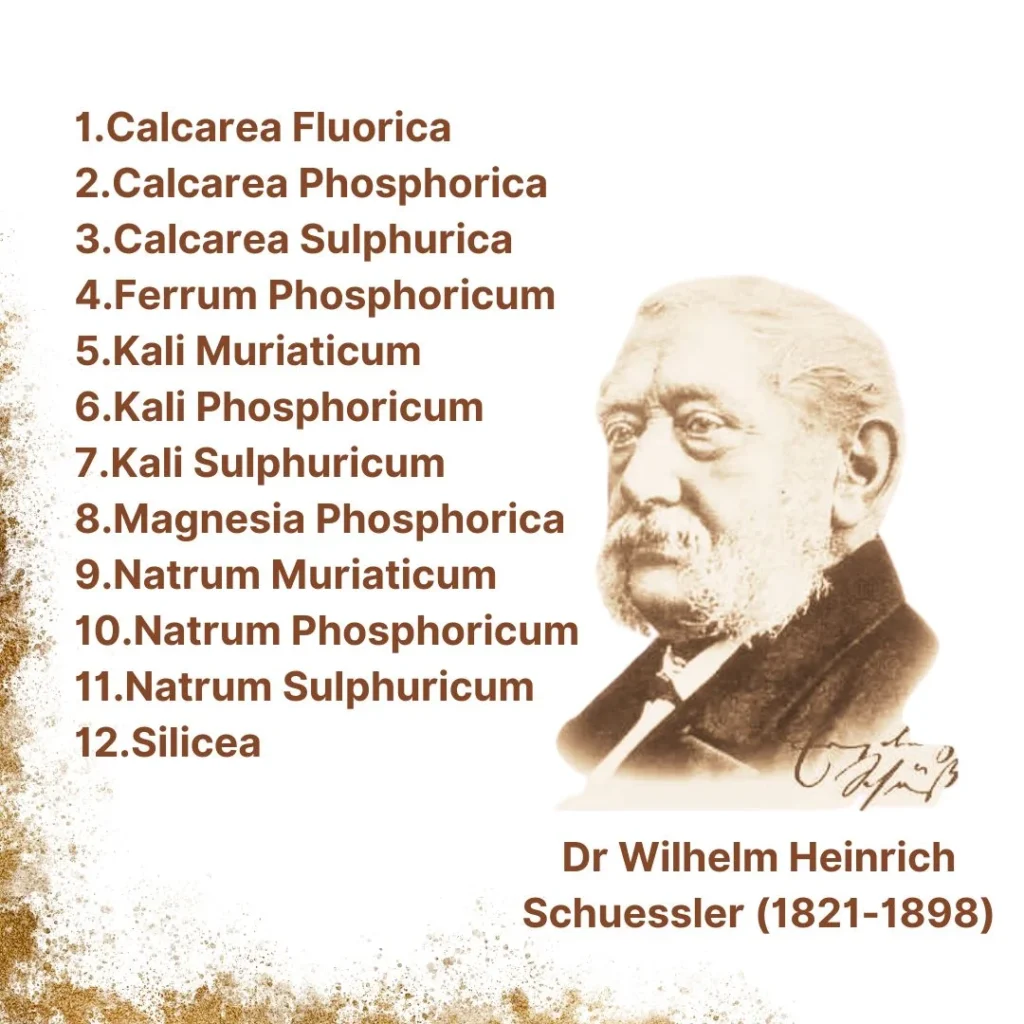
In the late 19th century, when homeopathy was gaining ground and modern medicine was evolving, one man dared to think differently—Dr. Wilhelm Heinrich Schuessler.
He was neither a conventional doctor nor a strict homeopath; instead, he carved out his own path by blending scientific knowledge with natural healing.
His discovery of the 12 Cell Salts, also known as biochemical therapy, laid the foundation for a simple yet powerful approach to health that remains relevant today.
But who was this man? What inspired him to create a whole new system of healing?
Let’s step into the world of Dr. Schuessler, explore the fascinating historical backdrop of his time, and uncover the genius behind the 12 Cell Salts.
Early Life and Medical Journey
Wilhelm Heinrich Schuessler was born on August 21, 1821, in Bad Zwischenahn, Germany.
Unlike many famous medical pioneers, he did not come from a wealthy or privileged background.
His early years were marked by financial hardship, but his insatiable curiosity and determination led him to pursue an education in medicine.
A Journey Through Europe
To refine his knowledge, Schuessler studied at prestigious universities across Europe:
- Paris – A hub of medical advancements
- Berlin – The epicenter of modern physiology
- Giesen – Where he earned his doctorate
While in Paris, Schuessler was introduced to Claude Bernard’s concept of the “milieu intérieur” (the body’s internal environment), which later influenced his idea that mineral salts are essential for maintaining cellular health.
He also explored Rudolf Virchow’s theories on cellular pathology, which proposed that diseases originate at the cellular level—a revolutionary idea at the time.
But Schuessler’s path took a unique turn when he encountered the works of Samuel Hahnemann, the founder of homeopathy.
The Birth of Biochemical Therapy
Inspired by homeopathy but skeptical of its complex system, Schuessler sought a simpler method that was scientific, logical, and effective.
He believed that:
- The human body is made up of essential mineral salts.
- A deficiency or imbalance of these salts leads to disease.
- Restoring balance with these salts can promote healing.
A Break from Traditional Homeopathy
- Unlike homeopathy’s “like cures like“ principle, Schuessler approach was nutritional and cellular—his remedies replenished missing minerals rather than triggering a reaction.
- In 1873, he published his groundbreaking work:
“Abridged Therapy Based on Physiology and Cellular Pathology”, introducing the 12 Biochemic Salts to the world.
Historical Context: Medicine in the 19th Century
To appreciate Schuessler work, we must understand the medical landscape of his time:
- Germ Theory was Emerging: Louis Pasteur and Robert Koch were making groundbreaking discoveries about bacteria, but antibiotics were still decades away.
- Surgery was Risky: Anaesthesia and antiseptic techniques were in their infancy.
- Pharmaceuticals Were Limited: Herbal remedies, homeopathy, and bloodletting were still commonly used.
In this era, Schuessler non-invasive, safe, and effective method offered a promising alternative, especially for those wary of harsh medical treatments.
The 12 Schuessler Cell Salts: A Breakthrough in Natural Healing
Dr. Schuessler identified 12 essential mineral salts, each playing a crucial role in cellular health.
Unlike conventional medicines, these were prepared in low homeopathic potencies (6X or 12X), allowing the body to absorb and utilize them efficiently.
Each salt targeted specific organs and functions, offering a simple yet powerful approach to healing.
The 12 Essential Cell Salts
- Calcarea Fluorica (Calc. Fluor.) – Strengthens bones, teeth, and skin elasticity
- Calcarea Phosphorica (Calc. Phos.) – Essential for bone growth and cell regeneration
- Calcarea Sulphurica (Calc. Sulph.) – Supports skin healing and detoxification
- Ferrum Phosphoricum (Ferr. Phos.) – First aid for inflammation and oxygen transport
- Kali Muriaticum (Kali Mur.) – Supports mucous membranes and detox processes
- Kali Phosphoricum (Kali Phos.) – The nerve tonic, combats stress and fatigue
- Kali Sulphuricum (Kali Sulph.) – Supports respiratory health and skin conditions
- Magnesia Phosphorica (Mag. Phos.) – Relieves muscle cramps and nerve pain
- Natrum Muriaticum (Nat. Mur.) – Regulates water balance and emotional well-being
- Natrum Phosphoricum (Nat. Phos.) – Balances acidity and aids digestion
- Natrum Sulphuricum (Nat. Sulph.) – Liver detox and bile production
- Silicea (Sil.) – Strengthens connective tissues, skin, hair, and nails
Challenges and Criticism
Schuessler’s work was met with both admiration and skepticism.
- Homeopaths criticized him for simplifying Hahnemann’s system.
- Conventional doctors dismissed his ideas as unscientific.
However, patients who used biochemical therapy found real results, and his popularity grew across Europe and America.
Even today, his 12 Cell Salts remain a cornerstone in naturopathy, homeopathy, and holistic medicine.
Schuessler’s Legacy: A Timeless Healing System
- Dr. Wilhelm Schuessler passed away in 1898, but his legacy lives on in millions of people who use his remedies.
Why His Work Still Matters Today
- Safe and Effective: Non-toxic, gentle remedies for chronic and acute conditions.
- Simple Yet Powerful: No need for complicated diagnoses.
- A Natural Approach: Supports the body’s own healing mechanisms.
His system bridged the gap between homeopathy and modern medicine, creating a timeless healing method that continues to help people worldwide.
Final Thoughts: The Future of Biochemical Therapy
As modern medicine advances, Schuessler’s principles remain surprisingly relevant.
With a growing shift towards holistic health, cellular nutrition, and natural remedies, his 12 Cell Salts are more popular than ever.
His genius lay in simplicity—he understood that true healing starts at the cellular level, a concept now validated by modern biochemistry.
So, the next time you feel unwell, perhaps the answer is not in complex drugs but in these 12 simple yet profound mineral salts.
